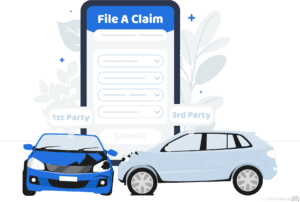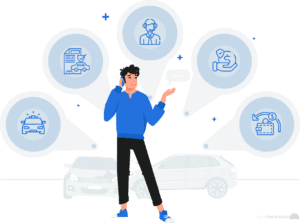

What Is Third-Party Car Insurance?
And why would you use it in at-fault accidents?
Compare quotes from top providers

If you are at fault in the accident, you may be subject to a third-party motor vehicle claim. A third-party claim is when a driver files a claim with someone else’s insurance provider to pay for their damages. If you’re the subject of a third-party claim, aside from your own recovery and the repair to your car, your insurance provider must pay the other party’s expenses as well.
These expenses can include property damages, bodily injury, costs of medical bills, and lost wages, up to the limits you’ve set, after you pay your deductible. Beyond that, you’re responsible for damages out of pocket, after what your third-party insurance covers.
Let’s go deeper into the world of third-party motor vehicle claims.
What Is Third-Party Car Insurance?

Third-party car insurance is when you file a claim with another person’s insurance provider to pay for your car repairs, medical expenses, and related transportation while your car is being repaired. You’d file a third-party claim if you got into an accident and were not at fault. If the accident was your fault, the other person would contact your insurance provider for a payout.
Who Are the Parties?
If your insurance provider is paying the claim, you are a third party, and the party being paid is the first party. Vice versa if you are the party not at fault who is receiving the money from the third party.
What Does Third-Party Car Insurance Cover and Not Cover?
Third-party car insurance doesn’t cover everything, even if you were found completely not at fault in an accident.
What It Covers
- In at-fault states: In at-fault states, if you’re found at fault for an accident, you’ll have to pay the other party’s medical and property damage costs.
- In no-fault states: In no-fault states, you’ll only have to pay the other person’s property damages (more on this below). Each party’s insurance pays for their own medical costs.
- Lost wages and other economic damages
What It Doesn’t Cover
- Theft
- Vandalism
- Weather-related events
- Potholes
In other words, third-party liability insurance doesn’t cover what comprehensive insurance does, which includes damages to your car from everything but other cars.
How Does Third-Party Car Insurance Work?

Confused? We’ll break down the third-party car insurance claims process from start to finish, starting with filing a claim.
Third-Party Car Insurance Claims
- To file a claim, contact your insurance provider and give them the accident details. You’ll want a police report in your claim, so it’s important to call the police after getting into a car accident, regardless of who was at fault.
- Your insurance provider will contact the other person’s insurance company and help you file a claim with it.
- To determine who was at fault, you’ll work with either a claims representative or insurance adjuster, who will gather information about the accidents from both parties. They also will inspect the vehicle, whether in person or in photos, along with the police report.
- The adjuster will determine who is at fault, and the person found at fault will pay for the other person’s medical and/or property damage costs, depending on the state.
- The third-party insurer will either reimburse the first party for their expenses or pay a repair shop directly.
FYI
You have the right to choose your own repair shop, even if it’s out of network for the third-party insurer. Get an estimate from a repair shop to see how much the repairs will cost.
No-Fault States
Things work a little differently if you live in a no-fault state. These are the no-fault states:
- Arkansas
- Delaware
- Florida
- Hawaii
- Kansas
- Kentucky
- Massachusetts
- Michigan
- Minnesota
- New Jersey
- New York
- North Dakota
- Pennsylvania
- Texas
- Utah
NOTE
In Kentucky, New Jersey, and Pennsylvania, you can choose whether you want liability vs. no-fault insurance1. No-fault insurance is often more expensive.
In no-fault states, rather than you filing a claim with another insurance provider to cover your medical expenses, your own medical coverage will cover your personal injuries. However, the other party will still be responsible for property damage, just not bodily injury2. Learn more about the difference between no-fault and at-fault states in our auto insurance FAQs page.
Recap
If you have property damage and/or bodily injury coverage, you already have third-party insurance coverage and may not even know it. Your state may even require it. Of course, the cost of third-party auto insurance is as varied as the cost of auto insurance in general, depending on factors such as your driving history, type of vehicle, and number of coverages.
Still, if you get into an accident and it’s not your fault, you’ll be grateful for third-party insurance, especially if you live in an at-fault state. This type of insurance will give you peace of mind in the form of property damage and bodily injury liability coverage.
Citations
What states have no-fault insurance? Nationwide. (2022).
https://www.nationwide.com/lc/resources/auto-insurance/articles/no-fault-insurance-statesWhat Is A Third-Party Insurance Claim?. Allstate. (2020, May).
https://www.allstate.com/tr/car-insurance/third-party-insurance-claims.aspx
